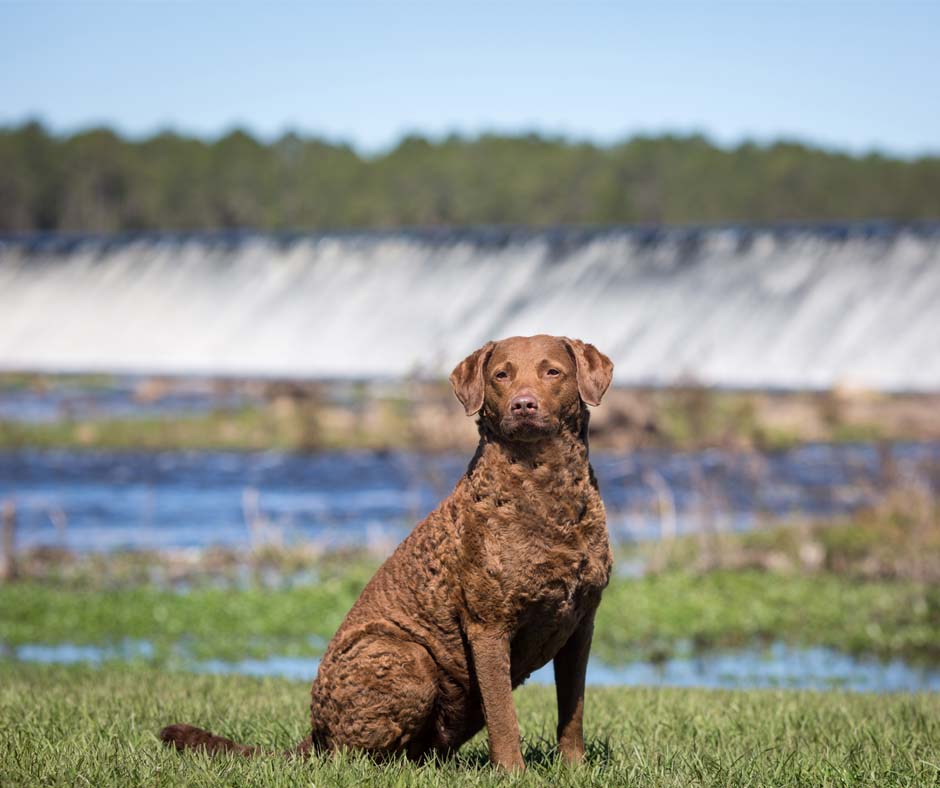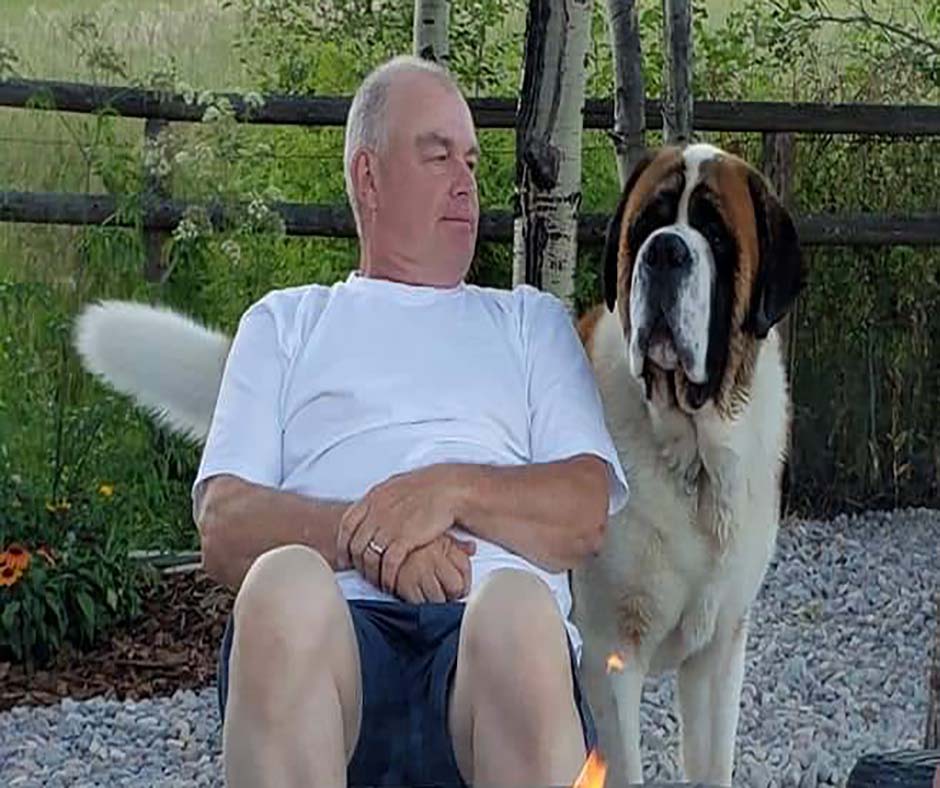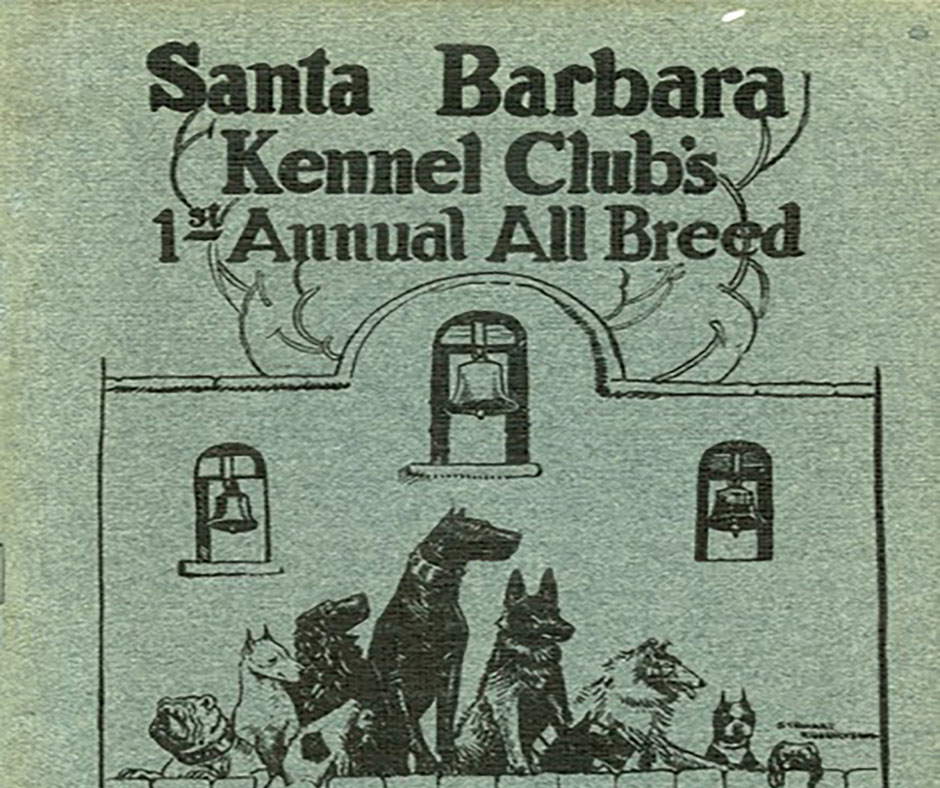Posts by Laura Reeves
518 – Ante Lucin on How to Help Dog Breeders in War Torn Ukraine
Ante Lucin on How to Help Dog Breeders in War Torn Ukraine
Ante Lucin, host of Talking Dogs With Ante, joins forces with Pure Dog Talk host Laura Reeves to share information supporting the dog people in Ukraine.
“What we have actually tried to do,” Ante said, “is that we have tried to place as much as possible information on our Facebook group. We try to connect directly with the people who are still in Ukraine. Try to find out what is that they need. Ukraine is a huge country, of course. There are still places which are not affected by the war, but there are places which are heavily affected by the war. One of them is obviously the capital city Kyiv. There is a lot of lot of dog people in Kyiv. For your viewers who maybe don’t know it, Ukraine is quite famous in Europe as a very professional organizer of dog shows. They are supposed to have the FCI world dog show in 2023. I mean their country has a lot of experience and a lot of good dog people.
“Unfortunately, at this point, things are quite difficult because in the places which are affected by the war at the moment it’s impossible to move. This is the biggest problem. There are still a lot of dog people, and there are still a lot of people in general, who would like maybe to go away from the war, at least children and women, because obviously for the men it’s not allowed to leave the country. But unfortunately when this all started, even though everybody newspapers, media, they were talking a lot about this, but actually it happened like a surprise to everybody.
“People who really managed to escape in the first 48 hours, they have managed. But the rest of the people are now very limited with the options which they can do. I’m really trying to connect all the people because I think that’s the most important thing at the moment. We are trying to see who needs help, where they need help and what kind of help they need. What has been happening in the last 48 hours, I know a lot of dog people from the neighboring countries like Hungary, Romania, Moldova they were driving till the border with Ukraine and the people from Ukraine where finding some kind of ways you know to send their own dogs.
“The thing is that there are unfortunately now a lot of people who cannot come to the border or who cannot organize the transport for their dogs to the border. I have read a lot of posts today where people are begging to find any kind of transportation, if not for human at least for the dogs.
“I’m going to repeat it 100 million times, people are amazing when it comes to these kind of situations and in any country, in any border that people are being able to send their dogs, we find people who will go there and who will catch the dogs and who will put them in the nice homes and everything. And the same for the people. In my group there are hundreds and hundreds of messages from people from all around the world who say we can take dogs, we can take people, we will help as much as we can.
“I go back to the fact that unfortunately now the people who are there mostly will have to stay there for some more time. What is now (an) emergency is the dog food. This is what I was talking with a lot of breeders in Ukraine I was talking with Helen who is the vice president of the Kennel Club, the dog food is a big problem. So what we are trying to see at the moment is we will try to connect with the Red Cross to see if there is a possibility to send some amounts of dog food with them.
“(We are trying) to connect with with any people who will possibly go till the border and take (dog food) from there, because there are obviously still some men who are driving women children and dogs till the border. So, whenever we find somebody like that, when we manage to organize that, somebody takes the dogs, we try to send back some dog food with them. So, it’s a lot of organization it’s not easy but it’s amazing how much that people want to help.
“The only thing what I can say from the other side of the border, that anyone in Ukraine wants to find a home for their own dogs or for them or for their children, as soon as they arrive to the border to any country Poland, Moldova, Romania, Hungary, there are dog people waiting for them with open hearts. All we can do is to pray that most of them will manage to save their lives and the lives of their children and their dogs.”
Since my conversation with Ante Sunday night, 2/27/2022, FCI has released the following information:
The FCI and its General Committee officially condemn the invasion of Ukraine by the armed forces of the Russian Federation. This conflict and aggression cannot leave anybody indifferent and we all feel concerned, sad and angry.
The invasion of Ukraine by the Russian Army has also put entire families of our dog community in complete distress. This war has placed our breeders and their dogs at great risk, directly threatening their welfare and their lives. Many had to flee, others are surviving in precarious conditions, hiding in shelters where food and basic commodities are becoming very scarce. Yet, in these terrible and trying times, they did not abandon their dogs!
These horrifying circumstances contradict the written priorities and welfare recommendations of the FCI, as well as our policy and aims.
The situation has led the FCI General Committee to hold an extraordinary meeting on Sunday, 27 February 2022. Important decisions were made, within the legal limits of the FCI and its General Committee, based on the FCI Statutes and Standing Orders.
From the 1st March 2022, and until further notice, the Russian Kynological Federation (RKF) will not be allowed to conduct – on the Russian Territory – any event wherein FCI titles or prizes are awarded (CACIB shows, CACIT trials, CACIAG competitions, etc.)
In order to give the opportunity to our Members/Contract Partners and any other persons to express their solidarity and help towards the Ukrainian people, their dog lovers/breeders/keepers, the FCI will open a bank account, specially for this purpose, where all donations are welcome and will be forwarded, with full transparency, to help the Ukrainian Kennel Union (UKU) and the Ukrainian breeders badly affected by the war and in serious need, living either in Ukraine or having fled to neighbouring countries.
The FCI will contribute to this fund in a substantial manner. Further details will be communicated in the following days.
The FCI is a huge community, a united and strong family so let us all stand up and show our solidarity for Ukraine!
517 — Veterinarian: Brachycephalic Does NOT Equal Unhealthy
Veterinary Insight on Why Brachycephalic Does NOT Equal Unhealthy
Dr. Maryanne Mack, DVM, breeder of top winning Boston Terriers, joins host Laura Reeves to discuss recent developments in Europe in regards to legislating the breeding of specific breeds.
“I went to vet school because I love purebred dogs,” Mack said. “I love their role as companions and I wanted to go to vet school really to focus on that role of the dog in our life… Just really wanting to work with people and their pets and breeders as well to just make healthier companions for all of us.

Photo of host Laura Reeves’ champion pug who likes to catch mice in her spare time.
“I think that the fact that a lot of groups have started to associate having a short face with being unhealthy is a really slippery slope that we don’t wanna go down. There’s a couple components of brachycephalic airway syndrome. Those are stenotic nares, or really tight nostrils, an elongated soft palate and a hypoplastic trachea. Those are sort of the three main issues that you see with brachycephalic airway syndrome.
“We don’t have any studies showing those are directly related to the length of the nose.
“The component that we really have to look for, that we know make the biggest difference in these dogs, is the elongated soft palate…
“That’s not related to how long the nose is, that’s related to different genes that are writing for the length of the soft palate. We see long soft palates in dogs with long noses. We see this in Labradors, we see this in mixed breed dogs. So, it’s not only a brachycephalic issue.
“I think it’s really important to note that these things can occur in any breed of dog. They do happen to occur more in brachycephalic dogs, but we don’t have concrete evidence that it’s directly related to the length of the nose.
“Most brachycephalic breeds, with the exception of some of the more mastiff types, these dogs were bred to be companions. That’s their job and they do that very, very, very well. Part of the reason we love them so much is that these brachycephalic facial features elicit almost an infantile like response to people. I think that focusing on the fact that these are companion dogs.
“These dogs are not out flushing birds, they’re not working dogs, they are meant to make people happy, sit on your lap. I absolutely believe that they should be able to do things like go on a little hike …. they should absolutely be able to do that and be able to breathe while they do that. But this is not a dog that’s out herding sheep in the summer. I think keeping that in perspective is really important.
“I think we need to focus, as preservation breeders, on doing a little bit of a better job on selecting breeding stock and producing healthier versions of every breed. But for brachycephalic, specifically, we all know that there are some dogs out there that are not good breathers and that happens.
“I think the hard part as a breeder is to say ‘OK this dog might be beautiful, this dog might have a great top line and this has great movement but he cannot breathe and I should probably put him in a companion home where he won’t be bred.’ That’s a really, really hard decision to make, but I think as we move forward, especially in this new culture and climate, we have to make more of those decisions.
Preservation Breeders are the Solution
“We as preservation breeders are actually the solution. We are the solution to this problem. If we work together to breed healthier dogs and if we work together to breed more of these dogs… I can’t tell you how many of my clients come in with a puppy mill puppy and they say ‘Well Dr. Mack, you told us some great breeders but we didn’t wanna wait for three years, so we ordered this one online and picked it up at the airport and here he is.’
“It breaks my heart because we as preservation breeders, if we had more available dogs that were well bred, people would buy them and they would love them. Vilifying people that breed more than one to two liters a year or whatever number you’ve decided is too many I think is detrimental to all of us.
“I first posted a statement in the beginning of 2020 basically saying I’m a veterinarian, I breed these dogs and it can be done right. These dogs are not inherently unhealthy. I received enormous backlash basically saying this veterinarian shouldn’t be a veterinarian, how can any veterinarian promote the breeding of brachycephalic dogs. It went so far as to contact my place of work, contacting me personally. I had to take my website down. I had to make everything private. I had to tell people who had wanted me to be an advocate for this I can’t do it right now because they’re coming for me.
“In the veterinary community I get backlash like ‘how can you breed these dogs.’ Oftentimes these people, once they meet my dogs and realize they can breathe and they’re healthy and they look great, they realize that we see a disproportionate number of unhealthy dogs just by the nature being veterinarians.
“I’ve actually done a little self-study where a dog comes to see me and I always find out where the dog came from. Then I make a note what issues does this dog have. About 95% of brachycephalic dogs I see that are bad breathers are from a pet store, a puppy mill or rescue. That is just the fact that I’ve gotten over six years of being a veterinarian, that these dogs are often the ones that they ordered online.”
Listen to this fabulous interview with Bulldog specialist Jay Serion to learn more about the Bulldog Club of America’s work on breeding healthy dogs. And this outstanding Love the Breeds episode with more information about Pugs from three nationally renowned breeders.
516 — Singleton Puppies: Whelping and Raising Strategies
Singleton Puppies: Whelping and Raising Strategies
For Valentine’s Day, Susan Patterson, moderator of the fabulous Canine, Fertility, Reproduction and Neonatal Issues Facebook group (invite required) and host Laura Reeves team up to talk about the dreaded Singleton… puppy that is. Susan and Laura discuss proper progesterone timing to help avoid a singleton litter in the first place, planning and managing a c-section if needed.
One is the Lonliest Number…
Singleton puppies present unique challenges for whelping and raising successfully. In large breed dogs, frequently the single puppy in utero does not release sufficient hormones to trigger the dam to start labor.
“This is again where progesterone timing, knowing your ovulation date, is important,” Susan said. “What most people fail to account for is placentas have an expiration date. You can’t go past that date or you will lose your puppy, there’s just no ifs, ands, or buts, and possibly your bitch. So knowing when the bitch is due is critical.
“Once you know when she’s due, you can be watching for labor to commence. I would strongly suggest you plan a C-section as a back-up, knowing you’re probably going to use it, but plan it as a backup. Give your bitch the chance to whelp naturally and then pull the trigger.
“The other thing, especially a day before you think you’re gonna have to pull the trigger, you’re gonna wanna be monitoring heartbeats. You don’t want your Singleton puppy to go into distress. If (the heartbeat) drops below 180 or 170 (bpm) I start getting really concerned.”
Management is job #1
Without the interaction of littermates, the singleton can overeat, under-exercise and may well need additional guidance to understand proper dog interactions.
Susan and Laura discuss monitoring the bitch for mastitis and the puppy to avoid gaining too much weight too quickly.
“The first thing I would do, is the minute she comes out of anesthesia is I would put her on sunflower lecithin,” Susan noted. “What the sunflower lecithin does, is it makes the milk less sticky, thins it down slightly, so that it passes through the memory glands much easier … it’s basically one teaspoon of sunflower lecithin for every 20 pounds of dog.
“A swimmer puppy is, it’s not just a condition of obesity, but that is definitely a contributing factor. So what you wanna do is you wanna have in your whelping box lots of hills and valleys. You wanna use pool noodles, rolled up bathroom rugs, anything to make that puppy work for dinner.”
Socializing singletons in other litters if possible and absolutely with safe adult dogs enables them to learn the critical life skill of appropriate interaction with other dogs as well as people.
Tune in for more of this great conversation.
514 – Chesapeake Bay Retrievers: An American Success Story
Chesapeake Bay Retrievers: An American Success Story
 Betsy Horn Humer has spent a lifetime with Chesapeake Bay Retrievers. Her parents acquired their first dog in 1947 and Betsy has been deeply involved in the breed since childhood. A conformation and obedience/rally judge, Betsy brings tremendous depth and width of experience to her understanding of the sport.
Betsy Horn Humer has spent a lifetime with Chesapeake Bay Retrievers. Her parents acquired their first dog in 1947 and Betsy has been deeply involved in the breed since childhood. A conformation and obedience/rally judge, Betsy brings tremendous depth and width of experience to her understanding of the sport.
“They’re very different from the other retrievers,” Betsy said. “They’re not like Goldens and Labs who love everybody and wanna be your friend. They’re much more reserved. They’re much more like some of the working breeds — German Shepherds and Dobermans, Rottweilers.
“They have a real work ethic and they’re serious. They’re much more serious than your average Golden and Labrador. They’re not the dog for everyone, especially a first dog.
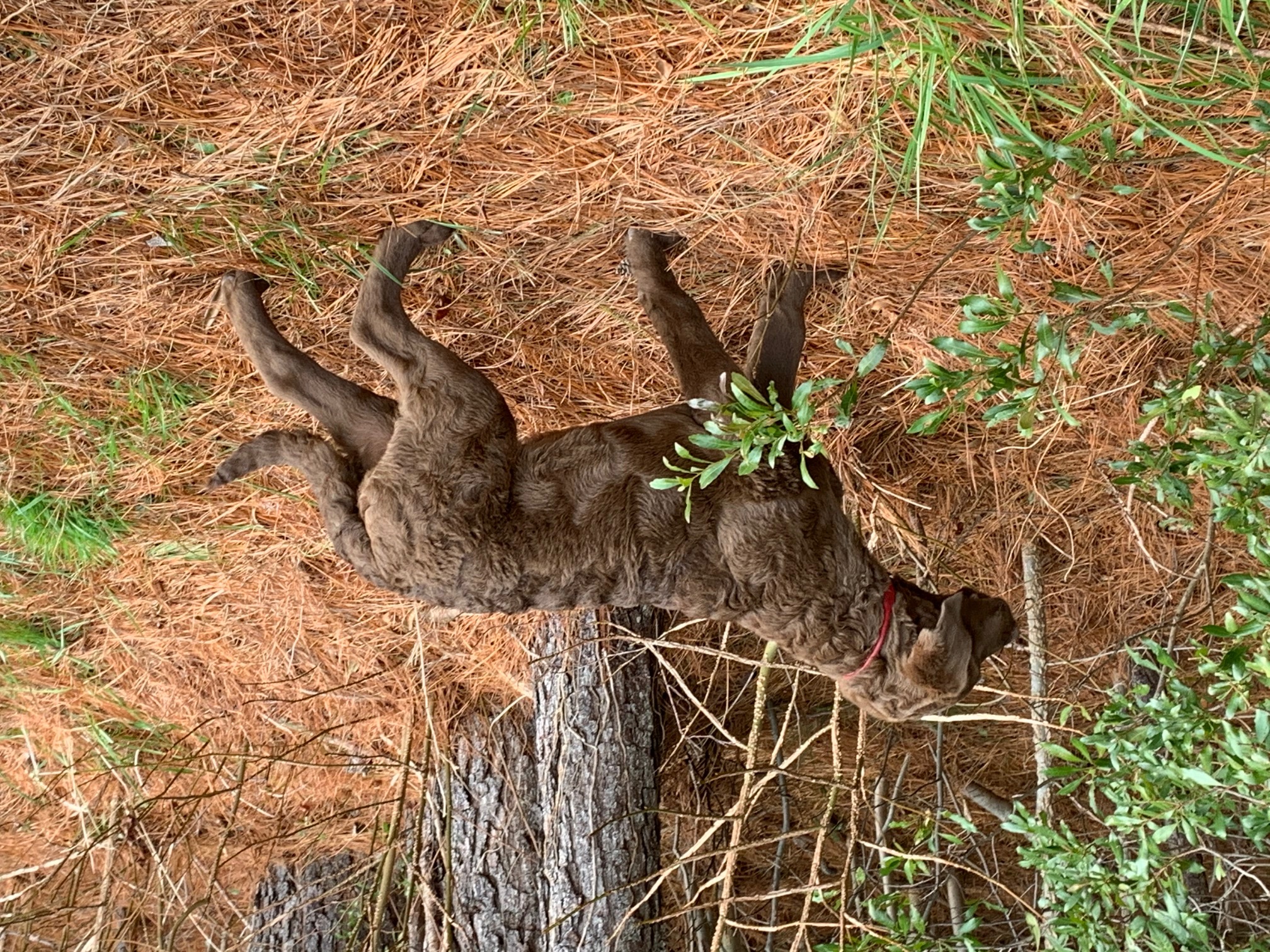 “They’re very protective and that’s really because of their heritage and why they were originally developed.
“They’re very protective and that’s really because of their heritage and why they were originally developed.
“They were originally developed on Chesapeake Bay, of course. The story is that there was a shipwreck. There were a couple of dogs on the ship and they swam to the shores. One was named Sailor and one was named Canton. They were not Chesapeakes but they were more like the Saint John’s dog. The Labrador also goes back to that particular breed.
“They were bred with a couple of the other local hunting dogs and some of the background includes setters and bloodhounds and other retrievers. It’s an interesting mix and it does explain why we do have different types of coats and different kinds of hound markings because of the genetics that’s actually behind the breed.
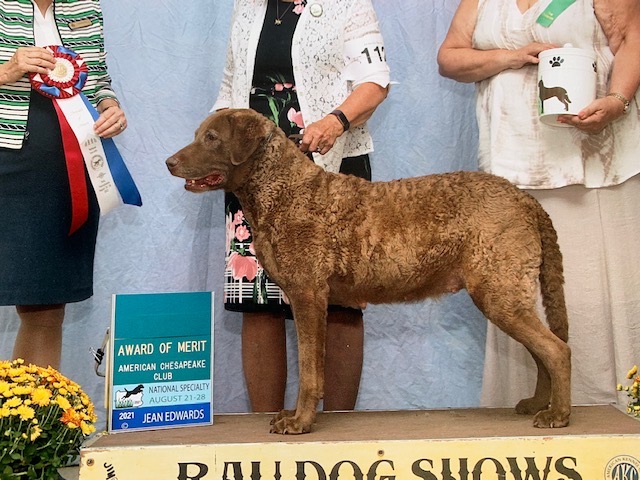
2021 National Specialty show- Award of Merit. GCHB Eastern Waters’ Pink Power O’MesaRidge, BN RI. Owners/ Breeders – Betsy Horn Humer & Rupert J. Humer
“The breed was really developed and records were kept by the wealthy land owners who owned property on the Chesapeake Bay and had huge hunting clubs. It was the local marketers, the duck hunters and the water fowlers that used them for hunting back in the late 1800s.
“There were no limits on how many ducks you could take and these hunters would take several hundred a day. The Chesapeake would just go out in the Bay and retrieve them all, that was his job. When he wasn’t actually swimming and retrieving, his job was to guard the pile of ducks so that nobody else would take them. These ducks were sold to expensive restaurants in Baltimore. They were considered a real treat.
“Winters were much colder then. There was ice to be broken. The Chesapeake Bay is huge. I mean you’re not talking just like a little lake it is huge. You get tremendous amounts of tides, wind. It can be a very unpleasant place during hunting season. But these hunters, that was how they made their living and that was what they did.
“(Chesapeakes) are very strong. They’re much stronger than they look. They’ve got very strong bone. Their coat was developed in order to keep them warm. They have what’s referred to as a double coat. There’s a very soft undercoat and it’s interesting because it’s all one hair. The tops of the hair are very coarse and wiry but as you get closer to the skin, the coat is actually very soft and the outside harshness keeps the inside, the other part of it, dry.”
Be sure to listen in to this wide ranging conversation for more insights on the Chesapeake, judging in the show ring and the obedience ring, dog breeding and more.
515 — Doing Battle Against Giardia and Coccidia
Doing Battle Against Giardia and Coccidia
Dr. Marty Greer, DVM joins host Laura Reeves to discuss how breeders and dog owners in general can do battle against the dreaded “bad potty bugs,” giardia and coccidia.
These single cell organisms can become endemic, Greer notes.
“You can’t get rid of it (on your property),” Greer said. “And that’s the bad news. There’s no really great treatment for either of them. There’s nothing you can do that’s going to disinfect your way out of it. We can’t vaccinate our way out of it. So we need to talk about all of our options.
“Many of the organisms that we see in the GI tract, whether it’s Giardia or coccidia or parvo, or tonight I got a text message from a lady in Florida about campylobacter, many of those are secondary to something else.
“So good gut health in general is your best defense. That’s really the primary backbone of what you can do. So that means a diet that’s appropriate, that doesn’t cause your dog to have diarrhea or loose stools. A probiotic that’s appropriate to keep the right bacteria there. Making sure you vaccinate for all the things you can vaccinate against, such as parvo. And making sure that you get regular fecal analysis done.
“One of the best defenses you have right now are the monthly heartworm preventives that you give orally… will give you better gut health because it controls intestinal parasites such as roundworms, hookworms and whip worms. So the fewer other things your dog’s body has to deal with, the healthier the gut, the better the dog’s overall health is going to be.
“The most commonly affected dogs that get sick are gonna be the younger ones or the dogs that are immunocompromised. So in general, if your dog has a little loose stool but they’re feeling OK, they’re eating OK, they’re not vomiting, everything is OK other than their stools are intermittently or consistently loose, you take a stool sample in to your vet and ask if they can send it to a reference lab if they can’t do Giardia testing.
“Treatment for coccidia is Albon. Number one, you have to weigh (your dog) so your dose is accurate. Number two, if you’re using the liquid, you have to shake it up really well because it does settle out.
“Treatment of Giardia, there is no labeled drug for use in the United States, but there are a couple that are commonly used and very effective. Metronidazole, fenbendazole (Do not use metronidazole on puppies that are very young or pregnant bitches) Panacur, Safeguard, those are fine.”
513 – Owner Handled Journey to Success
Owner Handled Journey to Success

L-R Jann Butler, Will Bratcher and Terri Ebert
Will Bratcher, Jann Butler and Terri Ebert make up the team behind 2021’s top winning Saint Bernard. Their story, and their journey, is an inspiration for everyone.
Will, an Olympic level swimmer, his wife Jann and their friend Terri have forged an impressive team in a very short time. Jann, who suffered a terrifying dog bite as a child, was not a dog person. Will, who grew up with 4H and animals, wanted a Saint Bernard.
After acquiring their first dog from the Thrifty Nickel, they wound up talking to Stan and Joan Zielinski about what would become their first show dog in 2014.
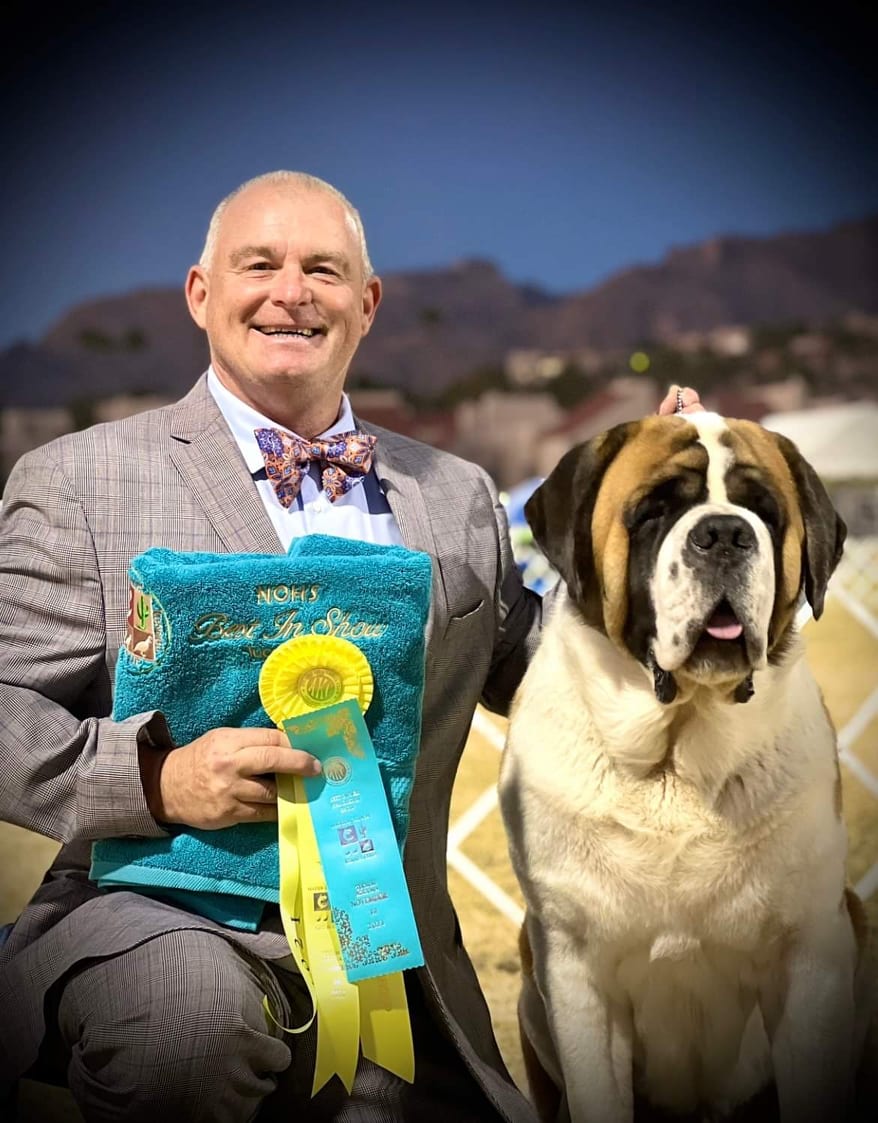
Will and Ian.
“I didn’t even know what a show home was,” Jann said. “After three interviews with the Zielinskis, we got this dog and we committed to show it. I’m like, I don’t even know what that is. But they sent us to (professional handler) Marty Glover. They said Marty will help you.
“OK great! So, we go meet Marty Glover and then the next thing you know, he takes the dog away to train him. Which I didn’t think was part of the deal but I was like, ‘oh that’s really weird you put your dog in a van with somebody else and they go away and they get trained.’
“Anyway, his first show he got a major as a puppy. And, of course, I had to ask ‘what’s a major’ and we learned a lot there right at the beginning.”
“You know Will,” Terri said. “Once he gets started …. for those of you that are interested, if you have someone like this in your family, you just roll with it. So Jann learned to roll with it. He said ‘well, I think we need a third dog.’ I mean who doesn’t want three Saint Bernards, which is equivalent to 450 pounds and so we roll with Will.
“We are consummate learners. There is no pride in how we enter this. We come in saying we don’t know anything so we’re willing to ask everything and we’ll ask anybody. And that’s a hallmark for us.
Stick and stay and make it pay
 “I think you do it for the fun,” Will said. “As soon as you lose that perspective you need to get out. The other one I have is “stick and stay and make it pay.” You learn a lot of things from training, working to build endurance and everything else.
“I think you do it for the fun,” Will said. “As soon as you lose that perspective you need to get out. The other one I have is “stick and stay and make it pay.” You learn a lot of things from training, working to build endurance and everything else.
“I apply the same thing towards my dogs (as in Olympic level swimming). I look at (Ian). I watch him just like my coach used to watch me. It’s about technique. It’s about endurance. It’s the whole package.
“For people who get into the owner handler, it’s scary at first. But when you really start winning, start doing, you forget about how nervous you used to be. Now you just start worrying about how did that handler do that, how am I running, … it’s just like running a race car too. You just wanna fine-tune and keep improving, and I still to this day.
“If I don’t think I did well, I’ll go to the judge and ask what can I do to improve. I’ve got judges just look at me (and say) ‘you sound like a junior handler.’ It all means everything to me. I’ve been getting a tremendous amount of coaching, encouragement and just that whole mentality of just keep going, keep going, don’t stop from the professional handlers.
“They’ve given me so much encouragement and help in handling and tips. There are so many things when you get down and nitty gritty. Just little things can make a big difference. So it’s been pretty humbling and I’ve really, really gotten quite an education. It’s not that easy. I have a lot more respect for handlers in general.”
Listen in to today’s show for the entirety of this heart-warming conversation.
512 – No Best in Show? Looking Back with Bo Bengtson
No Best in Show? Looking Back with Bo Bengtson
Author, historian, editor and Sighthound specialist Bo Bengtson joins host Laura Reeves again for a fascinating look back at dog shows *before* Best in Show.
“You gotta go several thousand years back basically,” Bengtson said of people appreciating the beauty of dogs. “Even in the Odyssey, which is Homer 2,000 years ago, there is a reference that cited the people who own dogs because they’re handsome, because they look good.
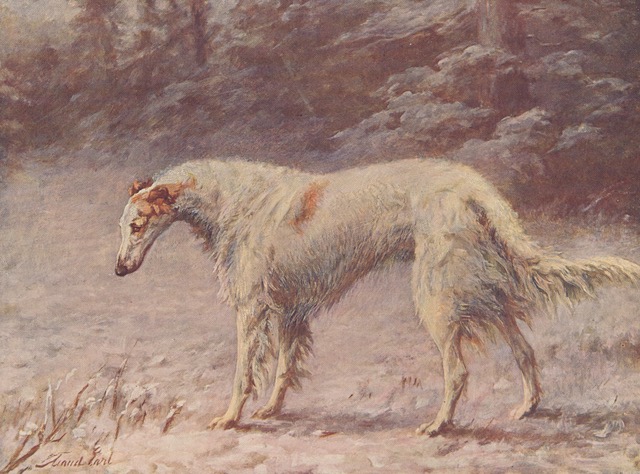
Sighthounds were a favorite subject of artists through the centuries, including this stunning Maude Earl Borzoi canvas.
“That’s kind of really interesting to me that even in those days people cared about what dogs look like. Going through the Middle Ages and forward, you find several references to not just hunting dogs or war dogs or something, but also to luxury dogs or pets. Greyhounds of all types are very, very frequently portrayed.
“And then we get up to the 1800s and middle of 1800s and the industrial revolution in England. Suddenly, there was a whole new class created by the industrial revolution. People who had money and had time on their hands and what could they better focus on than dogs. That was very interesting to them and that’s where the beginning of the modern dog sport really stands.
“The dog shows of the past were not at all like modern dog shows. There was often a best in show award but even defeated dogs could actually compete for it. There were no groups and there were not even necessarily breeds.
“In 1924, the American Kennel Club introduced new regulations and since then it’s basically been (the same). The number of groups has increased slightly and the number of breeds increased drastically, but their regulations for competing have remained unchanged.
“Even in my early days, in the 1980s in this country, there was not even necessarily Best in Show. I remember very, very vividly that I had a group winner who was not allowed to compete for Best in Show because there wasn’t a Best in Show at that show. In the beginning, only half the number of shows had the best in show award … eventually that grew up to present day.
“There have always been people who are nuts about competing for best in show and campaigning dogs. I mean you don’t think of people in the ‘30s or ‘40s or something that is campaigning dogs. But they were. There was that Pointer in 1860 or something from Wales, that was shown at least 60 times. How do they even get to the show? And he was shown overseas too. How do you even know where the shows were? It’s amazing.
“In the 1950s, there were certainly not flights available as today and there were far fewer shows and dogs still managed to win 20 or 30 best in shows per year. People were competitive even then.
“I think it’s a pretty rarified sport in many ways. I mean they make it fun sometimes and I think it’s fascinating. I think there’s nothing like sitting with a catalog and watching a bunch of dogs of the same breed being judged by an expert. That’s totally fascinating. But most people don’t think so. I think you need a special type of interest or mind or something like that. Maybe you have to just be a little weird.”
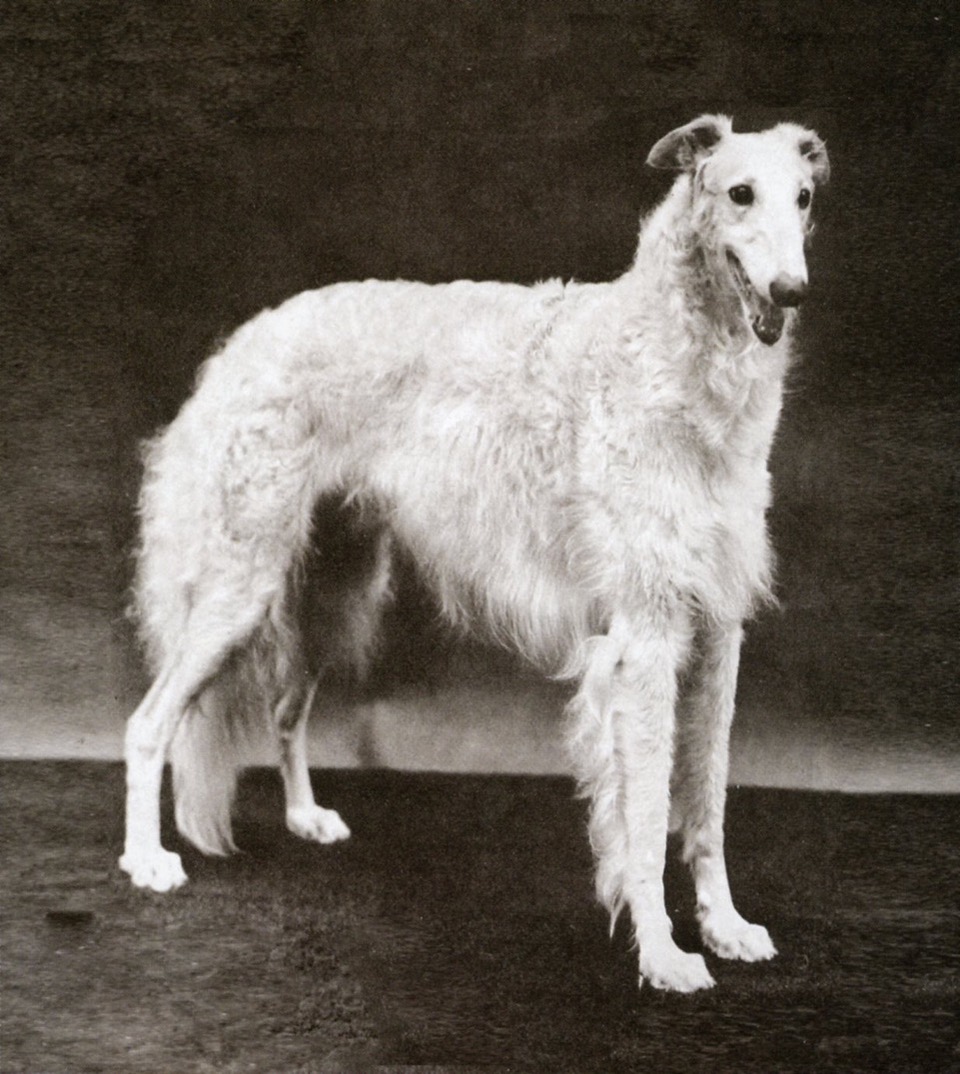
Spoiler alert, a photo of Bo’s hound group winner, in his dream BIS lineup, the great Borzoi Vigow…
Be sure to listen in to catch Bo’s incredible Best in Show lineup representing dogs of yesteryear through present times.
Purchase Bo’s encyclopedic and gorgeous book Best In Show here and visit his fascinating Facebook page of Great Show Dogs of the Past here.
511 – What IS the Animal Rights Agenda? With Patti Strand
What IS the Animal Rights Agenda? With Patti Strand
Patti Strand, president of the National Animal Interest Alliance (NAIA), joins host Laura Reeves to discuss proposed ballot initiatives that have appeared, in identical form, in multiple states with a definite “animal rights” agendas attached.
The current initiative in Oregon and the previous one in Colorado aimed to criminalize injuring or killing animals, including killing for food, hunting, fishing and criminalizes most breeding practices.
Strand contends that it is unlikely the Oregon proposal will receive enough signatures to make it on the ballot, and the Colorado one did not, but that we should always “be aware.”
“It is possible that other groups will come together and urge this sort of thing to get put on the ballot,” Strand said. “But again, since they’re going after every use of animals, in my opinion, it’s unlikely to succeed anywhere. Not only because it’s way too broadly comprised but also because none of the national groups with money would put money into it.
“But this is all part of the animal rights agenda. The animal rights agenda is opposed to using animals for any purpose, regardless of how humane, how responsible or how much benefit might flow from using animals in this way to people and other animals. A great deal of medical research is done on animals, for animals. So clearly there’s an animal rights to agenda behind this.
“I will say that (since) it lacks funding from the big organized groups, either (the initiative sponsors) just didn’t understand the process and what they were going to be up against in the beginning or it’s a shot across the bow, to let us know ‘we’re still here and this is truly exactly what we want.’
“You do have to be aware that there are people out there, and that you’re associating with them every day, maybe they’re not even on the other side, but they definitely have been the recipients of a lot of misinformation and information that’s told from a very biased point of view. Propaganda is everywhere.
“One of my favorite articles is from a speech (by) Michael Crichton, the guy who wrote Jurassic Park, and it’s his speech to the Commonwealth and he opens it up by saying ‘I’ve been asked to speak to you today and to tell you what I think is the greatest threat facing mankind. And I have a fundamental answer. It is the ability to discern reality from fiction.’ So, we’re in a propaganda war.
“You know, one of the major goals of the animal rights movement is to turn us all into guardians instead of owners. You have to be very very careful that you don’t fall into that trap. When you say you’re your pet’s guardian or you are a pet parent or whatever, you are moving the goal post a little bit in their direction. Obviously, you don’t wanna sound cold and heartless, because that plays into the agenda, too. So, it’s just about being sensitive to the language itself and being very, very aware.
“The truth will set you free. I’m really big on truth telling and just being very honest and open about what you do, what it means, why it matters. You can’t speak in sound bites and win. If you try to come up with a sound bite that is going to be the perfect rejoinder to what they just said, you’re gonna lose.
“Those of us who spend our entire lives with dogs, put every extra dime we have into our dogs, who spend more at veterinarians than many, many people spend on their kids… I mean, we love our dogs deeply. We just don’t confuse them with people. We know that they are dogs and we take care of them.”
510 – Tackling a Stinky Problem with Dr. Marty Greer
Tackling a Stinky Problem with Dr. Marty Greer
Dr. Marty Greer, DVM and host Laura Reeves tackle a stinky problem – the dog’s anal glands. Greer explains how to express them, what to do if they are infected or impacted and stinky stories from the trenches.
“They’re the same glands that are the scent glands on a skunk, the scent glands in a ferret,” Greer said. “The ferret ones are, of course, removed if ferrets are going to become pets. They serve as a communication function among animals. So for instance, when the skunk is upset or angry or being attacked or whatever, they’ll turn and lift their tail and their anal sacks will express and that’s a form of a communication and defense. So unfortunately, when our dogs get nervous, or scared, yeah, sometimes they express their anal glands.
“There’s just normal anal gland secretions, then there are the impacted ones, when the material gets thick and doesn’t express normally. Then we can see them become infected. They can come in with a bloody kind of discharge in the anal gland. We can see them abscess through the skin, where the dog comes in, clients don’t really understand what happened, it looks like there’s this opening of this hole next to the rectum…
“A lot of anal sac abscesses are associated with diarrhea. So if the dog has had a loose stool, then some of the watery stool, instead of it passing the anal gland, it will push down into the opening, set up housekeeping in that little gland and set up a bacterial infection. So, most dogs will comfortably empty them on their own, but if they don’t and they get an infection then of course we have to treat that.
“From a perspective of ‘does the dog need their anal glands,’ really it’s not necessary. It’s a communication tool. So, when you see dogs greet each other, dogs that aren’t familiar with one another, they go tails and nose, nose to tail, ’cause they’re sniffing each other’s anal glands as a handshake, as an identification. Really, it’s only for social communication that the dogs need their anal glands. In today’s society, they don’t need to warn other dogs that there is a predator out there, they live on your couch. It’s better off to not have them if you’re having a dog that’s having chronic problems.”
509 — 12-Steps to a Happier You in the Dog Fancy
12-Steps to a Happier You in the Dog Fancy
I don’t know about you, but this holiday season I just haven’t had the vibe. I’ve honestly tried. But, all my magic spells for maintaining a positive attitude have been, at best, modestly successful. Even a week at the ocean didn’t cure me this time and that’s my solid go to.
Pretty sure I don’t have to run the litany we all know too well about the “why”. It’s just plain been a rough couple years. The global psyche is literally bruised and battered. Peace on Earth and goodwill to mankind seem like quaint notions of a bygone era. These notions could just as easily apply to the Ming Dynasty for all of their relevance in our world today.
What we all need is a 12-step program for happiness… Fortunately, I have just the thing! Lol
I wrote the following in 2015 for the now-defunct Best In Show Daily online mag back when I was a weekly columnist there.
These steps apply to our dog event world specifically, but can be generalized to daily life without much trouble in three simple rules. Just be nice. Get off your bleeping phone. Learn new things.
I may or may not have included this ditty in a previous episode, but if so, even I can’t find it! Lol
12-Steps to a Happier You in the Dog Fancy
January: Say “Congratulations” to the winner or “Thank You” to those who congratulate you. Yes, every time. Yes, even when the winner is your most bitter enemy, actually, especially then.
February: Watch one breed, other than your own, from start to finish, at every dog show you attend.
March: Instill and enforce the “first to look at their phone during dinner pays for everyone” rule each time you go out to eat, whether at a dog show, with co-workers or family. Experience the miracle of direct human interaction.
April: Seek out a club official — show chair, chief ring steward, hospitality chair, etc — at each dog show you attend and thank them, personally, for their hard work and compliment them on a specific piece of the show which you particularly liked. Resist the urge to complain about anything.
May: Volunteer to help at one show. Even if it is an hour of ring stewarding, helping with clean up or set up, judging a fun match, simply restocking the candy dishes or picking up someone else’s poopie. Do one thing for a club for no better reason than you can.
June: Help someone new. It could be as simple as assisting someone with an armband. Maybe a promising youngster with a new puppy shows up and would welcome five minutes of *kind* and constructive direction. It is important here to understand the concept of help. Focus on the positive. Just be nice.
July: Organize a potluck. Get a whole bunch of people together at someone’s RV or grooming space, even invite someone you don’t know well, break bread together. Laugh. Tell stories. Talk dogs. If there is a water balloon fight somewhere in the mix, this cannot be a bad thing. Remember, we’re still carrying each month’s goal forward, so March’s “no phone” rule applies. By now, it should be ingrained and much easier to implement.
August: Read the standard for a breed about which you know nothing. Then, at the next show, while continuing your February goal of watching a new breed, go find the breed you read about. See if you can apply elements of the standard to dogs in the ring.
September: Go back to school … In your own breed. Re-read your breed standard. Memorize it. Commit the entire standard to memory so thoroughly that you can quote entire sections verbatim. Then pull a random dog out of your pack, stack him up and go over him piece by piece according to the standard. Try very, very hard to be objective and not make excuses. Simply see what’s there and what isn’t.
October: Take the skeletons out of your closet. Look at them in the cold light of day. Whether as a breeder, handler, exhibitor or judge, take a look at your past mistakes, acknowledge them, then burn them at the stake and move on!
November: Talk turkey. Get off the internet blogs and approach a more experienced person about a question in your breeding program, grooming routine, handling skill set, whatever. Talk to them in person. Invite them to lunch or drinks. Do not expect miraculous secrets, but acknowledge and respect someone outside your comfort zone. You learn something new every day!
December: Give the gift of your time and energy to a local animal shelter, rescue group or other doggie emergency support system.
This 12-step program is guaranteed to bring enhanced enjoyment, satisfaction, curiosity, knowledge, camaraderie and success to anyone’s dog show calendar. Make the New Year the best ever!
I’m off to cook a simple Christmas Dinner for two, snuggle some dogs and curl up for a long winter’s nap.
Wishing everyone the gladness of Christmas, which is hope;
the spirit of Christmas, which is peace;
the heart of Christmas, which is love.
PureDogTalk’s ORIGINAL 12 days of Christmas…
On the first day of Christmas, my true love gave to me, a puppy in a sherpa bag…
(Caveat, never give a puppy for a Christmas present!)
On the second day of Christmas, my true love gave to me, two towel rolls for my puppy in a sherpa bag…
On the third day of Christmas, my true love gave to me, three air fresh’ners, two towel rolls for my puppy in a sherpa bag…
On the fourth day of Christmas, my true love gave to me four show collars, three air fresh’ners, two towel rolls for my puppy in a sherpa bag…
On the fifth day of Christmas, my true love gave to me, five cooooover ads… four show collars, three air fresh’ners, two towel rolls for my puppy in a sherpa bag…
On the sixth day of Christmas, my true love gave to me, six Sprinter tires, five cooooover ads… four show collars, three air fresh’ners, two towel rolls for my puppy in a sherpa bag…
On the seventh day of Christmas, my true love gave to me, seven shiny suits, six Sprinter tires, five cooooover ads… four show collars, three air fresh’ners, two towel rolls for my puppy in a sherpa bag…
On the eighth day of Christmas, my true love gave to me, eight sensible shoes, seven shiny suits, six Sprinter tires, five cooooover ads… four show collars, three air fresh’ners, two towel rolls for my puppy in a sherpa bag…
On the ninth day of Christmas, my true love gave to me, nine doggies dancing, eight sensible shoes, seven shiny suits, six Sprinter tires, five cooooover ads… four show collars, three air fresh’ners, two towel rolls for my puppy in a sherpa bag…
On the tenth day of Christmas, my true love gave to me, ten tongues a wagging, nine doggies dancing, eight sensible shoes, seven shiny suits, six Sprinter tires, five cooooover ads… four show collars, three air fresh’ners, two towel rolls for my puppy in a sherpa bag…
On the eleventh day of Christmas, my true love gave to me, eleven puppies squalling, ten tongues a wagging, nine doggies dancing, eight sensible shoes, seven shiny suits, six Sprinter tires, five cooooover ads… four show collars, three air fresh’ners, two towel rolls for my puppy in a sherpa bag…
And, on the twelfth day of Christmas, my true love gave to me, twelve friendly judges, eleven puppies squalling, ten tongues a wagging, nine doggies dancing, eight sensible shoes, seven shiny suits, six Sprinter tires, five cooooover ads… four show collars, three air fresh’ners, two towel rolls for my puppy in a sherpa bag…




